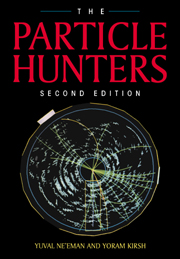Book contents
- Frontmatter
- Contents
- Preface to the first edition
- Preface to the second edition
- 1 The building blocks of the atom
- 2 Physical laws for small particles
- 3 The discoveries of the 1930s and 1940s
- 4 Particle accelerators — or from hunters to farmers
- 5 Strange particles
- 6 Basic forces and the classification of particles
- 7 Conservation laws
- 8 Short-lived particles
- 9 To the quarks — via the eightfold way
- 10 More quarks — or charm, truth and beauty
- 11 The Standard Model and beyond
- Appendix 1 Properties of semi-stable particles
- Appendix 2 The Greek alphabet
- Name index
- Subject index
Preface to the first edition
Published online by Cambridge University Press: 05 August 2012
- Frontmatter
- Contents
- Preface to the first edition
- Preface to the second edition
- 1 The building blocks of the atom
- 2 Physical laws for small particles
- 3 The discoveries of the 1930s and 1940s
- 4 Particle accelerators — or from hunters to farmers
- 5 Strange particles
- 6 Basic forces and the classification of particles
- 7 Conservation laws
- 8 Short-lived particles
- 9 To the quarks — via the eightfold way
- 10 More quarks — or charm, truth and beauty
- 11 The Standard Model and beyond
- Appendix 1 Properties of semi-stable particles
- Appendix 2 The Greek alphabet
- Name index
- Subject index
Summary
Since its very beginning, physics has pondered the question of what are the fundamental building blocks of matter. In the last century all matter was shown to be composed of atoms. In this century, science has taken a further step forward, revealing the internal structure of the atom. Today, the fact that the atomic nucleus consists of protons and neutrons, and that electrons move around it, is common knowledge. But the story does not end there. Over the past 40 or 50 years it has been found that in collisions between sub-atomic particles additional particles are formed, whose properties and behaviour can shed light on the basic laws of physics. All these particles were called — somewhat unjustifiably — elementary particles.
The study of the sub-atomic structure has led to the development of two branches of modern physics: nuclear physics, which is concerned with furthering the understanding of the atomic nucleus as a whole and the processes going on inside it, and elementary particle physics, the new frontier, which deals with the properties and structure of the various particles themselves and the interactions between them. Up until the end of the 1940s, elementary particle physics had been regarded as a part of nuclear research, but in the 1950s it achieved the status of an independent branch of physics.
Information
- Type
- Chapter
- Information
- The Particle Hunters , pp. xiii - xivPublisher: Cambridge University PressPrint publication year: 1996
